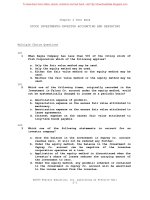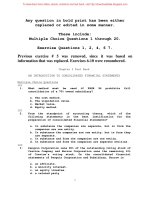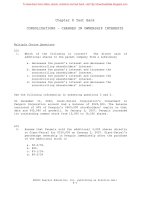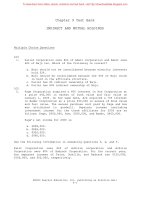Test bank strategic staffing 2e by philips gully chapter 08
Bạn đang xem bản rút gọn của tài liệu. Xem và tải ngay bản đầy đủ của tài liệu tại đây (136.65 KB, 14 trang )
Strategic Staffing, 2e (Phillips/Gully)
Chapter 8 Measurement
1) Criterion data is information about measures used to make projections about outcomes.
Answer: FALSE
Diff: 1
Page Ref: 200
Skill: Concept
Objective: 1
2) Class ranking and finish place in a race are examples of ratio measures.
Answer: FALSE
Diff: 1
Page Ref: 200
Skill: Concept
Objective: 2
3) A task knowledge test in which a candidate is expected to score at least 75 out of 100 to
advance to the next stage in the selection process is an example of a criterion-referenced
measure.
Answer: TRUE
Diff: 1
Page Ref: 200
Skill: Concept
Objective: 2
4) A normal curve typically is typically bimodal.
Answer: FALSE
Diff: 1
Page Ref: 202
Skill: Concept
Objective: 2
5) Scores on norm-referenced measures have meaning only when compared to the scores of
others.
Answer: TRUE
Diff: 1
Page Ref: 201
Skill: Concept
Objective: 2
6) The median describes the arithmetic average of the scores in a distribution.
Answer: FALSE
Diff: 1
Page Ref: 202
Skill: Concept
Objective: 2
1
Copyright © 2012 Pearson Education, Inc. Publishing as Prentice Hall
7) A personality test that correlates -0.5 with job performance should not be used to make
staffing decisions.
Answer: TRUE
Diff: 1
Page Ref: 205
Skill: Concept
Objective: 3
8) Administering a computer test of programming skills in the same way to every job candidate
is an example of reliability.
Answer: FALSE
Diff: 1
Page Ref: 216
Skill: Concept
Objective: 5
9) Assessing whether two interviewers rate the same candidate's interview the same is an
example of test-retest reliability.
Answer: FALSE
Diff: 1
Page Ref: 214
Skill: Concept
Objective: 5
10) If all the candidates who score high on a skills test go on to have high job performance, the
skills test has high criterion-related validity.
Answer: TRUE
Diff: 1
Page Ref: 217
Skill: Concept
Objective: 5
11) Correlation analysis can only assess the relationship between two variables.
Answer: TRUE
Diff: 1
Page Ref: 205
Skill: Concept
Objective: 3
12) The median is the score that is in the 50th percentile.
Answer: TRUE
Diff: 1
Page Ref: 202
Skill: Concept
Objective: 2
13) Standard scores are raw scores that have been converted into an expression of the percentage
of people who score at or below that score.
Answer: FALSE
Diff: 1
Page Ref: 202
Skill: Concept
Objective: 2
2
Copyright © 2012 Pearson Education, Inc. Publishing as Prentice Hall
14) Construct validity reflects the perceived job relatedness of a measure.
Answer: FALSE
Diff: 1
Page Ref: 217
Skill: Concept
Objective: 5
15) False positives occur when a weak applicant is erroneously classified as being a good hire.
Answer: TRUE
Diff: 1
Page Ref: 221
Skill: Concept
Objective: 6
16) Predictive data is information used to ________.
A) measure important outcomes of the staffing process
B) categorize people into appropriate labels
C) make projections about desired outcomes
D) assess central tendency
Answer: C
Diff: 1
Page Ref: 200
Skill: Concept
Objective: 1
17) Information about important outcomes of the staffing process is called ________.
A) predictive data
B) criterion data
C) reliability
D) validity
Answer: B
Diff: 1
Page Ref: 200
Skill: Concept
Objective: 1
18) Years of experience, salary in dollars, and weight are examples of what type of measure?
A) nominal
B) ordinal
C) interval
D) ratio
Answer: D
Diff: 1
Page Ref: 200
Skill: Concept
Objective: 2
3
Copyright © 2012 Pearson Education, Inc. Publishing as Prentice Hall
19) Edwin is the HR manager at a customer care unit with close to 1,000 employees. He wants to
statistically analyze the service data to make the recruitment process more effective by
identifying desirable and undesirable qualities of employees. Edwin decides to use ratio
measurement to measure the customer handling time for each employee. Which of the following,
if true, would specifically support the decision to gauge turnaround time using ratio
measurement?
A) Edwin plans to analyze the data using techniques such as correlation and statistical modeling.
B) Edwin wants to measure call data accurately by using an absolute scale.
C) Edwin is trying to obtain a ranking of the employees rather than finding the extent of
difference in productivity.
D) Edwin wants to reduce the complexity of the observations drawn from the analysis.
Answer: B
Diff: 3
Page Ref: 200-201
Skill: Critical thinking
Objective: 2
AACSB: Reflective thinking skills
20) If job candidates must be able to lift 40 pounds to be allowed to advance to the next stage of
the hiring process, lifting ability is what type of measure?
A) criterion-referenced
B) norm-referenced
C) standardized
D) subjective
Answer: A
Diff: 1
Page Ref: 201
Skill: Application
Objective: 2
AACSB: Analytic skills
21) If the top scoring thirty percent of job applicants on a job knowledge test advance to the next
stage of the hiring process regardless of their job knowledge test score, the job knowledge test is
what type of measure?
A) criterion-referenced
B) norm-referenced
C) standardized
D) subjective
Answer: A
Diff: 1
Page Ref: 201
Skill: Application
Objective: 2
AACSB: Analytic skills
4
Copyright © 2012 Pearson Education, Inc. Publishing as Prentice Hall
22) When are the mean, median, and mode like to be at the same point in a distribution of
scores?
A) when the sampling error is high
B) when the distribution is positively skewed
C) when the distribution is negatively skewed
D) when the distribution is a normal curve
Answer: D
Diff: 1 Page Ref: 202
Skill: Concept
Objective: 2
23) What would the median of the following distribution be 2, 3, 3, 3, 3, 4, 5, 6, 7, 8, 8?
A) 3
B) 4
C) 5
D) 6
Answer: B
Diff: 1
Page Ref: 202
Skill: Application
Objective: 2
AACSB: Analytic skills
24) What would the mode of the following distribution be 2, 3, 3, 3, 3, 4, 5, 6, 7, 8, 8?
A) 3
B) 4
C) 5
D) 6
Answer: A
Diff: 1
Page Ref: 202
Skill: Application
Objective: 2
AACSB: Analytic skills
25) Which of the following refers to the spread of the data around the midpoint?
A) variability
B) validity
C) coefficient
D) regression
Answer: A
Diff: 1
Page Ref: 202
Skill: Concept
Objective: 2
5
Copyright © 2012 Pearson Education, Inc. Publishing as Prentice Hall
26) What would the range of the following distribution be 2, 3, 3, 3, 3, 4, 5, 6, 7, 8, 8?
A) 3
B) 4
C) 5
D) 6
Answer: D
Diff: 1
Page Ref: 202
Skill: Application
Objective: 2
AACSB: Analytic skills
27) Which of the following values is closest to the standard deviation of the following
distribution 2, 3, 3, 3, 3, 4, 5, 6, 7, 8, 8?
A) 0
B) 2
C) 5
D) 6
Answer: B
Diff: 1
Page Ref: 202
Skill: Application
Objective: 2
AACSB: Analytic skills
28) Which of the following is true of a distribution with positive skew?
A) The scores will mostly be in the negative end of the distribution.
B) The mode falls between the mean and the median.
C) The mode would be shifted to the right of the distribution.
D) The mean would be to the left of the distribution.
Answer: D
Diff: 2
Page Ref: 202
Skill: Concept
Objective: 2
29) If a test score is at the 90th percentile, then which of the following is true?
A) Only 10% of the test takers scored higher than this.
B) This is in the bottom 10% of the distribution.
C) About 90% of the test takers scored higher than this.
D) This is the most commonly observed score in the test.
Answer: A
Diff: 2
Page Ref: 202
Skill: Application
Objective: 2
AACSB: Analytic skills
6
Copyright © 2012 Pearson Education, Inc. Publishing as Prentice Hall
30) A ________ indicates how many standard deviations above or below the mean a given score
lies.
A) norm-referenced measure
B) raw score
C) criterion-referenced measure
D) standard score
Answer: D
Diff: 1
Page Ref: 203
Skill: Concept
Objective: 2
31) Which of the following is true of a z score of -3.2 in a distribution?
A) The score lies above the mean of the distribution.
B) Performance is lower than the group average.
C) The score is above the 50th percentile.
D) Several people scored below this score.
Answer: B
Diff: 2
Page Ref: 203
Skill: Application
Objective: 2
AACSB: Analytic skills
32) The correlation coefficient between a selection test and job performance is 0. This means the
selection test ________.
A) perfectly predicts job performance
B) and job performance are unrelated
C) has adverse impact on job performance
D) is positively related to job performance
Answer: B
Diff: 2
Page Ref: 205
Skill: Concept
Objective: 3
7
Copyright © 2012 Pearson Education, Inc. Publishing as Prentice Hall
33) Edwin is the HR manager at a customer care unit with close to 1,000 employees. He wants to
statistically analyze the service data to make the recruitment process more effective by
identifying desirable and undesirable qualities of employees. Edwin observes a high positive
correlation between the employees' ability to adapt and the turnaround time. However, he
decides to avoid using this criterion when recruiting employees. Which of the following, if true,
would MOST strengthen this decision to avoid the criterion?
A) The statistical significance of the correlation was found to be sixty percent.
B) Another trait, honesty, had a higher correlation coefficient than employees' ability to adapt.
C) The sample size used by Edwin was significantly larger than what was required.
D) Multiple regressions were observed among the variables used for the analysis.
Answer: A
Diff: 3
Page Ref: 208
Skill: Critical thinking
Objective: 3
AACSB: Reflective thinking skills
34) If the correlation coefficient for the relationship between a job sample test and job
performance is -0.7 and significant then the employer should ________.
A) not hire people who pass the test
B) hire people who score high on the job sample test
C) hire people who score low on the job sample test
D) rerun the analyses because a coefficient of -0.7 is impossible
Answer: C
Diff: 2
Page Ref: 208
Skill: Application
Objective: 3
AACSB: Analytic skills
35) When predictor and job performance scores have been obtained, the predictor can be
considered valid and useful if the correlation coefficient ________.
A) has both practical and statistical significance
B) has statistical significance alone
C) is insignificant
D) has practical significance alone
Answer: D
Diff: 2
Page Ref: 208
Skill: Concept
Objective: 3
8
Copyright © 2012 Pearson Education, Inc. Publishing as Prentice Hall
36) Which of the following is true about multiple regressions?
A) It allows the use of one predictor when predicting an outcome.
B) It works only on variables that are at the interval or ratio level.
C) The higher the correlation between variables the greater the regression.
D) Regression is done in the form of an equation.
Answer: D
Diff: 1
Page Ref: 208
Skill: Concept
Objective: 3
37) The following equation is the result of performing a multiple regression analysis:
Job performance = 10 + (5 = job knowledge) + (0.7 = conscientiousness), where job knowledge
is measured on a scale of 0-5 and conscientiousness is measured on a scale of 0 to 100. Which of
the following conclusions is correct?
A) Conscientiousness is less important than job knowledge.
B) If a person scored 5 on job knowledge and 100 on conscientiousness he or she would have the
maximum predictive score possible.
C) Neither job knowledge nor conscientiousness predicts performance.
D) If a person scored 0 on both job knowledge and conscientiousness, his or her predictive score
is 0.
Answer: B
Diff: 2
Page Ref: 210
Skill: Synthesis
Objective: 5
AACSB: Analytic skills
38) How dependably or consistently a measure assesses a particular characteristic is the
measure's ________.
A) reliability
B) validity
C) standardized score
D) percentile
Answer: A
Diff: 1
Page Ref: 210
Skill: Concept
Objective: 5
39) Failure to measure important aspects of the attribute to be measured results in ________
error.
A) deficiency
B) random
C) contamination
D) standard
Answer: A
Diff: 1
Page Ref: 212
Skill: Concept
Objective: 5
9
Copyright © 2012 Pearson Education, Inc. Publishing as Prentice Hall
40) When multiple versions of the same test are developed to deter cheating, which of the
following reliabilities is used to ensure the two forms are comparable?
A) test-retest reliability
B) inter-rater reliability
C) parallel forms reliability
D) internal consistency reliability
Answer: C
Diff: 1
Page Ref: 213
Skill: Concept
Objective: 5
41) The extent to which items on a given measure assess the same construct is assessed by
________.
A) test-retest reliability
B) inter-rater reliability
C) parallel forms reliability
D) internal consistency reliability
Answer: D
Diff: 1
Page Ref: 214
Skill: Concept
Objective: 5
42) Which of the following is true regarding the standard error of measurement (SEM)?
A) The SEM is a useful measure of the accuracy of individual scores.
B) The higher the SEM, the more accurate the measurements.
C) With longer periods between administrations, SEMs are likely to go down.
D) If the SEM is 1, then the observed score is the true score.
Answer: A
Diff: 2
Page Ref: 214-215
Skill: Concept
Objective: 5
43) If the items on an assessment method do not seem to be job-related, then, which of the
following is true?
A) The assessment method's criterion-related validity is low.
B) The assessment method's construct validity is low.
C) The assessment method's face validity is low.
D) The assessment method's content validity is low.
Answer: C
Diff: 2
Page Ref: 217
Skill: Concept
Objective: 5
10
Copyright © 2012 Pearson Education, Inc. Publishing as Prentice Hall
44) Asking all job candidates questions from the same interview schedule in the same way is an
example of ________.
A) validity
B) correlation
C) reliability
D) standardization
Answer: D
Diff: 2
Page Ref: 222
Skill: Concept
Objective: 6
45) The ________ is the percent of employees who are defined as currently successful
performers.
A) base rate
B) selection ratio
C) SEM
D) coefficient
Answer: A
Diff: 1
Page Ref: 223
Skill: Concept
Objective: 6
46) What is the difference between predictive and criterion data and how is each used?
Answer: Predictive data is information about measures used to make projections about
outcomes. For example, data collected to predict turnover or job performance is predictive data.
Similarly, one could measure the intelligence of job candidates to see if it predicts some
component of job success. This is also predictive data. In terms of the general staffing system,
predictive data can come from any part of the hiring process and can include information on
sourcing quality, the basic qualifications of applicants, and their traits, competencies, and values.
Criterion data is information about important outcomes of the staffing process. Traditionally, this
data includes measures of the job success of employees. Criterion data can include job
performance, training outcomes, promotability ratings, days missed, safe work days, and any
other job outcome of interest. At a general level, criterion data can also include all outcome
information relevant to the evaluation of the effectiveness of the staffing system against its goals.
This can include measuring a company's return on investment related to its staffing measures,
employee job success, time-to-hire, time-to-productivity, promotion rates, turnover rates, and
new hire fit with company values.
Criterion data is used to measure and assess desired outcomes of interest. Predictive data is used
to make predictions about those outcomes. If statistically and practically significant relationships
are found between predictive and criterion data, then the predictors can and should be used to
make staffing decisions. This type of data-based decision making will provide a competitive
advantage to organizations over those that do not use data to make staffing decisions.
Diff: 1
Page Ref: 200
Skill: Concept
Objective: 1
11
Copyright © 2012 Pearson Education, Inc. Publishing as Prentice Hall
47) What are norm- and criterion-referenced measures and when is each appropriate?
Answer: For criterion-referenced measures, or standards-based assessments, the scores have
meaning in and of themselves. This approach is most appropriate when the measure has a clearly
definable connection to a particular knowledge, skill, or ability and measurable standards for
passing have been established. For example, firefighter candidates might be expected to reach a
certain criterion measure, such as running up four flights of stairs in full gear in a certain amount
of time before they can advance to the next stage of the hiring process. Another example is
passing a written driver's license with a score of 85% correct or better. On criterion-referenced
measures it is easy to see what a particular score indicates about proficiency or competence.
Norm-referenced measures have meaning only when compared to the scores of others. For
example, a score of 80 on a leadership inventory means nothing by itself. The relevance of the
score is established in reference to the scores of others. If the scores of average score was 70 then
clearly 80 is above average whereas if the average score was 90 then clearly 80 is below average.
The variability of the scores of others also is an important consideration. Often it is useful to
convert raw scores on norm-referenced measures into standard scores (or percentiles) because
this provides the kind of comparative information needed to use the scores.
Diff: 1
Page Ref: 201
Skill: Concept
Objective: 2
48) Why is standardization crucial for effective measurement? What are the properties of a
standardized measure?
Answer: Standardization is crucial for effective measurement because it increases accuracy,
improves comparability of scores, increases reliability, reduces contamination error, and
enhances validity. Standardization is the consistent administration and use of a measure. It
reflects the consistency and uniformity of the conditions as well as the procedures for
administering an assessment method. Computerization helps to ensure that all respondents
receive the same instructions and the same amount of time to complete the assessment.
Standardization increases the fairness of the assessment system. Because maintaining
standardized conditions is the responsibility of the people administering the assessment, training
all administrators in proper procedures and control of conditions is critical. This is true for
interviewing as well as any other assessment approach. In addition to being legally important,
standardization is also valuable because recruiters should consistently evaluate candidates on
their competencies, styles, and traits.
Diff: 1
Page Ref: 214
Skill: Concept
Objective: 6
12
Copyright © 2012 Pearson Education, Inc. Publishing as Prentice Hall
49) What are reliability and validity, and why do they matter in staffing?
Answer: Reliability refers to how dependably, or consistently, a measure assesses a particular
characteristic. Validity is the most important issue in selecting a measure. It refers to how well a
measure assesses a given construct and the degree to which specific conclusions can be made or
predictions based on observed scores. Validity is the cornerstone of strategic staffing. Obviously,
if the measures are low in reliability (taking into account the type of reliability being considered)
then validity is difficult to establish.
Both are critical to staffing because effective staffing systems use high quality data to infer
relationships and make predictions. It is difficult to identify determinants of job success if the
data is low in reliability and validity. As a result, the measures will not be useful. Reliability is
also important because it ensures that the scores and data used are representative of people's true
scores. Validity is also important because it ensures that the tests are measuring what is being
measured and that the assessments are useful for predicting job related outcomes. Thus, validity
establishes the legal defensibility of the staffing system. Ultimately, high-quality talent can be
predicted using various kinds of tests, then they give a competitive edge over firms that do not
use valid tests for selection. Reliability and validity increase the likelihood that employers will
be able to predict high quality talent.
Diff: 1
Page Ref: 210-215
Skill: Concept
Objective: 6
13
Copyright © 2012 Pearson Education, Inc. Publishing as Prentice Hall
50) Describe how you would create and validate an assessment system.
Answer: Begin with a job analysis to understand determinants, requirements, and indicators of
job success. This helps identify the important knowledge, skills, abilities, and other
characteristics (KSAOs) and competencies required of a successful employee. Clearly
understand what it is that you want to measure and the reasons for measurement.
Next, identify reliable and valid methods of measuring or assessing important KSAOs or
competencies. Either collect data to conduct a reliability analysis or refer to published materials
to determine if acceptable levels of reliability exist, taking into consideration the type of
reliability being evaluated. Next, develop a system for collecting the data. A variety of methods
for measuring important characteristics are available and it is important to establish the integrity
and usefulness of the data generated by each measure. Examine each measure to ensure that it
has an appropriate mean and standard deviation and look for measures that appear to have useful
variation. Then, collect measures of job success and either correlate or regress them with
predictive measures. Regression analysis can be used to evaluate any redundancies among the
measures and to assess how well the group of measures predicts job success.
After establishing which measures predict job success best, examine the potential adverse impact
and cost of the measures. Use the validity of information along with cost and adverse impact to
determine the final set of measures. Next, develop a method for combining the scores. For
example, one can probably use the regression equation to weight the scores. Additionally,
develop selection rules to determine which scores are considered passing.
Implement the assessment system, ensuring that those assessing candidates or using the system
are properly trained. Attempt to standardize the testing and assessment conditions. Ensure that
assessment instruments are kept secure and maintain confidentiality of results. Finally,
periodically reevaluate the usefulness and effectiveness of the system to ensure that it continues
to predict job success without adverse impact or exceptional cost.
Diff: 2
Page Ref: 222
Skill: Synthesis
Objective: 6
AACSB: Analytic skills
14
Copyright © 2012 Pearson Education, Inc. Publishing as Prentice Hall









